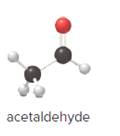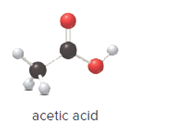
General, Organic, and Biological Chemistry - 4th edition
4th Edition
ISBN: 9781259883989
Author: by Janice Smith
Publisher: McGraw-Hill Education
expand_more
expand_more
format_list_bulleted
Question
Chapter 7, Problem 64P
Interpretation Introduction
(a)
Interpretation:
The intermolecular force exhibited by the following compound is to be depicted.

Concept Introduction:
The intermolecular force is defined as the force which occurs between the one molecule to another as attraction. This intermolecular force is of following types −
- London Dispersion force
- Hydrogen bond
- Dipole-Dipole interaction
Interpretation Introduction
(b)
Interpretation:
The intermolecular force exhibited by the following compound is to be determined.

Concept Introduction:
The intermolecular force is coined as the force which occurs between the one molecule to another as attraction. This intermolecular force is of following types −
- London Dispersion force
- Hydrogen bond
- Dipole-Dipole interaction
Expert Solution & Answer
Want to see the full answer?
Check out a sample textbook solution
Students have asked these similar questions
true or false,the equilibrium constant for this reaction is 0.50.PCI5(g) ↔ PCI3(g) + CI2(g)Based on the above, the equilibrium constant for the following reaction is 0.25.2PCI5(g) ↔. 2PCI3(g) + 2CI2(g)
true or false, using the following equilibrium, if carbon dioxide is added the equilibrium will shift toward the productsC(s) + CO2(g) ↔ 2CO(g)
2S2O2/3- (aq) + I2 (aq) ---> S4O2/6- (aq) +2I- (aq)
Experiment
I2 (M)
S2O3- (M)
Initital Rate (M/s)
1
0.01
0.01
0.0004
2
0.01
0.02
0.0004
3
0.02
0.01
0.0008
Calculate the overall order for this reaction using the table data
a) 3b) 0c) 2d) 1
Chapter 7 Solutions
General, Organic, and Biological Chemistry - 4th edition
Ch. 7.1 - Prob. 7.1PCh. 7.2 - Convert each pressure unit to the indicated unit....Ch. 7.3 - Prob. 7.2PPCh. 7.3 - Prob. 7.2PCh. 7.3 - Prob. 7.3PPCh. 7.3 - Prob. 7.3PCh. 7.3 - Prob. 7.4PPCh. 7.3 - Prob. 7.4PCh. 7.3 - The pressure inside a 1.0-L balloon at 25C was 750...Ch. 7.4 - A sample of nitrogen gas contains 5.0 mol in a...
Ch. 7.4 - Prob. 7.7PPCh. 7.4 - Prob. 7.5PCh. 7.5 - Prob. 7.8PPCh. 7.5 - Prob. 7.6PCh. 7.6 - CO2 was added to a cylinder containing 2.5 atm of...Ch. 7.6 - Prob. 7.10PPCh. 7.6 - Prob. 7.7PCh. 7.7 - Prob. 7.8PCh. 7.7 - Prob. 7.9PCh. 7.7 - Prob. 7.11PPCh. 7.7 - Which species in each pair has stronger...Ch. 7.7 - Prob. 7.12PPCh. 7.7 - Prob. 7.11PCh. 7.8 - Prob. 7.13PPCh. 7.8 - Would you predict the surface tension of gasoline,...Ch. 7.9 - Prob. 7.13PCh. 7.10 - Prob. 7.14PPCh. 7.10 - The human body is composed of about 70% water. How...Ch. 7.10 - How much energy is required to heat 28.0 g of iron...Ch. 7.10 - Prob. 7.15PCh. 7.10 - Prob. 7.16PPCh. 7.10 - If the initial temperature of 120. g of ethanol is...Ch. 7.11 - Use the heat of fusion of water from Sample...Ch. 7.11 - Answer the following questions about water, which...Ch. 7.11 - Prob. 7.19PPCh. 7.12 - Answer the following questions about the graph...Ch. 7.12 - How much energy (in calories) is released when...Ch. 7.12 - How much energy (in calories) is required to melt...Ch. 7 - Prob. 19PCh. 7 - Prob. 20PCh. 7 - Prob. 21PCh. 7 - The compressed air tank of a scuba diver reads...Ch. 7 - Assume that each of the following samples is at...Ch. 7 - Use the diagrams in problem 7.23 to answer the...Ch. 7 - Prob. 25PCh. 7 - Prob. 26PCh. 7 - Prob. 27PCh. 7 - Prob. 28PCh. 7 - Prob. 29PCh. 7 - Prob. 30PCh. 7 - Prob. 31PCh. 7 - Prob. 32PCh. 7 - Prob. 33PCh. 7 - If you pack a bag of potato chips for a snack on a...Ch. 7 - Prob. 35PCh. 7 - Prob. 36PCh. 7 - Prob. 37PCh. 7 - Prob. 38PCh. 7 - Prob. 39PCh. 7 - Prob. 40PCh. 7 - Prob. 41PCh. 7 - Prob. 42PCh. 7 - Prob. 43PCh. 7 - Prob. 44PCh. 7 - Prob. 45PCh. 7 - Prob. 46PCh. 7 - Prob. 47PCh. 7 - Consider balloons A and B, which contain CH4 and...Ch. 7 - Prob. 49PCh. 7 - Prob. 50PCh. 7 - Prob. 51PCh. 7 - Prob. 52PCh. 7 - Prob. 53PCh. 7 - Prob. 54PCh. 7 - Prob. 55PCh. 7 - Prob. 56PCh. 7 - Prob. 57PCh. 7 - Prob. 58PCh. 7 - Prob. 59PCh. 7 - Prob. 60PCh. 7 - Prob. 61PCh. 7 - Prob. 62PCh. 7 - Prob. 63PCh. 7 - Prob. 64PCh. 7 - Which molecules are capable of intermolecular...Ch. 7 - Prob. 66PCh. 7 - Prob. 67PCh. 7 - Explain why the boiling point of A is higher than...Ch. 7 - Prob. 69PCh. 7 - Prob. 70PCh. 7 - Prob. 71PCh. 7 - Prob. 72PCh. 7 - Prob. 73PCh. 7 - Prob. 74PCh. 7 - Prob. 75PCh. 7 - Prob. 76PCh. 7 - Prob. 77PCh. 7 - Prob. 78PCh. 7 - Prob. 79PCh. 7 - Prob. 80PCh. 7 - Prob. 81PCh. 7 - How many calories of heat are needed to increase...Ch. 7 - Prob. 83PCh. 7 - If it takes 37.0 cal of heat to raise the...Ch. 7 - Prob. 85PCh. 7 - What phase change is shown in the accompanying...Ch. 7 - Prob. 87PCh. 7 - Which process requires more energy, melting 250 g...Ch. 7 - Consider the cooling curve drawn below a. Which...Ch. 7 - Prob. 90PCh. 7 - Draw the heating curve that is observed when...Ch. 7 - Prob. 92PCh. 7 - Use the following values to answer each part. The...Ch. 7 - Prob. 94PCh. 7 - Prob. 95PCh. 7 - Prob. 96PCh. 7 - Prob. 97PCh. 7 - Explain why you feel cool when you get out of a...Ch. 7 - Prob. 99CPCh. 7 - As we learned in Chapter 5, an automobile airbag...
Knowledge Booster
Similar questions
- the decomposition of N2O5 is the first order with a half-life of 1.98 minutes. If the inital concentration of N2O5 is 0.200 M, what is the concentration after 6 minutes?a) 0.612 Mb) 0.035 Mc) 0.024 Md) 0.100 Marrow_forward20.00 mL of 0.150 M HCI is titrated with 0.075 M NaOH. What volume of NaOH is needed?a) 50 mLb) 20 mLc) 40 mLd) 26.66 mLarrow_forward20.00 mL of 0.150 M NaOH is titrated with 37.75 mL of HCI. What is the molarity of the HCI?a) 0.150 Mb) 0.079 Mc) 0.025 Md) 0.050 Marrow_forward
- in the following reaction, the OH- acts as which of these?NO2- (aq) + H2O (l) ⇌ OH- (aq) + HNO2 (aq)a) not a weak acidb) basec) acidarrow_forwardfind the pH of a buffer made from 0.20 M HNO2 and 0.10 M NaNO2. Ka= 4.0 x 10-4a) 4.00b) 3.40c) 3.70d) 3.10arrow_forwardthe Ka for sodium dihydrogen phosphate is 6.32 x 10-8. Find the pH of a buffer made from 0.15 M H2PO4- and 0.15 M HPO42-.a) 6.98b) 7.42c) 7.00d) 7.20arrow_forward
- Find the equilibrium concentration of H3O+ starting with 0.072 M solution of acetic acid. Ka = 1.8 x 10-5. Acetic acid is HC2H3O2 (aq).HC2H3O2 (aq) + H2O (l) ⇌ H3O (aq) + C2H3O2- (aq) a) 1.3 x 10-6 b) 1.1 x 10-3 c) 1.5 x 10-2 d) 3.6 x 10-5arrow_forwardin VSEPR Theory, AX2 isarrow_forwardcalculate the pH of 0.066 M Ca(OH)2. Remember stoichiometry.arrow_forward
- Find the equilibrium concentration of H3O+ starting with 0.072 M solution of acetic acid. Ka = 1.8 x 10-5. Acetic acid is HC2H3O2 (aq).HC2H3O2 (aq) + H2O (l) ⇌ H3O (aq) + C2H3O2- (aq)arrow_forwardin VSEPR Theory AX2 isa) tetrahedralb) octahedralc) lineard) trigonal bipyramidarrow_forwardCheck How many signals would you expect to find in the H NMR spectrum of each given compound? Part 1 of 2 Part 2 of 2 Br Br 2. Cl X 2 © 2025 McGraw Hill LLC. All Rights Resarrow_forward
arrow_back_ios
SEE MORE QUESTIONS
arrow_forward_ios
Recommended textbooks for you
 Chemistry for Today: General, Organic, and Bioche...ChemistryISBN:9781305960060Author:Spencer L. Seager, Michael R. Slabaugh, Maren S. HansenPublisher:Cengage Learning
Chemistry for Today: General, Organic, and Bioche...ChemistryISBN:9781305960060Author:Spencer L. Seager, Michael R. Slabaugh, Maren S. HansenPublisher:Cengage Learning Chemistry: The Molecular ScienceChemistryISBN:9781285199047Author:John W. Moore, Conrad L. StanitskiPublisher:Cengage Learning
Chemistry: The Molecular ScienceChemistryISBN:9781285199047Author:John W. Moore, Conrad L. StanitskiPublisher:Cengage Learning Chemistry: Principles and PracticeChemistryISBN:9780534420123Author:Daniel L. Reger, Scott R. Goode, David W. Ball, Edward MercerPublisher:Cengage Learning
Chemistry: Principles and PracticeChemistryISBN:9780534420123Author:Daniel L. Reger, Scott R. Goode, David W. Ball, Edward MercerPublisher:Cengage Learning Introductory Chemistry: An Active Learning Approa...ChemistryISBN:9781305079250Author:Mark S. Cracolice, Ed PetersPublisher:Cengage LearningChemistry: Matter and ChangeChemistryISBN:9780078746376Author:Dinah Zike, Laurel Dingrando, Nicholas Hainen, Cheryl WistromPublisher:Glencoe/McGraw-Hill School Pub Co
Introductory Chemistry: An Active Learning Approa...ChemistryISBN:9781305079250Author:Mark S. Cracolice, Ed PetersPublisher:Cengage LearningChemistry: Matter and ChangeChemistryISBN:9780078746376Author:Dinah Zike, Laurel Dingrando, Nicholas Hainen, Cheryl WistromPublisher:Glencoe/McGraw-Hill School Pub Co

Chemistry for Today: General, Organic, and Bioche...
Chemistry
ISBN:9781305960060
Author:Spencer L. Seager, Michael R. Slabaugh, Maren S. Hansen
Publisher:Cengage Learning

Chemistry: The Molecular Science
Chemistry
ISBN:9781285199047
Author:John W. Moore, Conrad L. Stanitski
Publisher:Cengage Learning

Chemistry: Principles and Practice
Chemistry
ISBN:9780534420123
Author:Daniel L. Reger, Scott R. Goode, David W. Ball, Edward Mercer
Publisher:Cengage Learning

Introductory Chemistry: An Active Learning Approa...
Chemistry
ISBN:9781305079250
Author:Mark S. Cracolice, Ed Peters
Publisher:Cengage Learning

Chemistry: Matter and Change
Chemistry
ISBN:9780078746376
Author:Dinah Zike, Laurel Dingrando, Nicholas Hainen, Cheryl Wistrom
Publisher:Glencoe/McGraw-Hill School Pub Co
